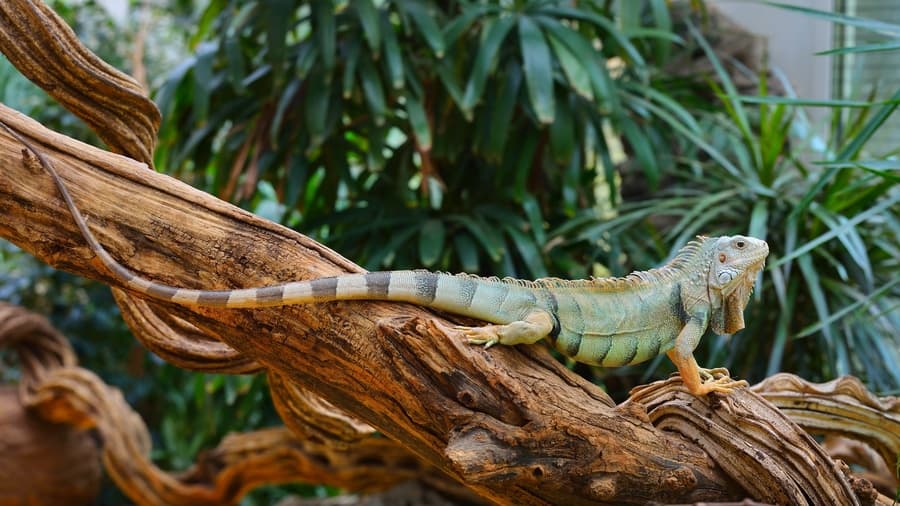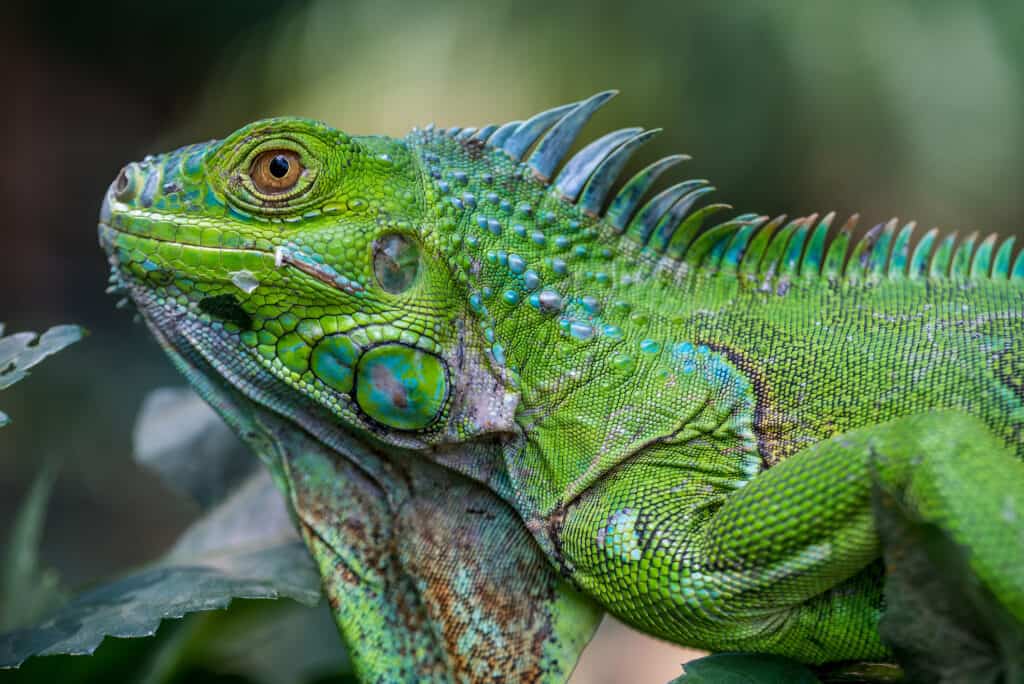Green Iguanas are an excellent option for families and children if you consider keeping a lizard as a pet. One of the unique features of Iguanas is the ability to drop its tail under the threat of danger.
Green iguanas can drop their tails as a defense response to danger which causes no real harm to the gecko. They can regrow their tails within 1-6 months after loss.
In the wild, lizards have evolved to drop their tails whenever the animal is in danger. It is mostly an automatic response to scare or distract predators so they can get away.
This article focuses on Green Iguanas and whether or not they can drop their tails at will. You will also learn about the different conditions influencing the tail regeneration in a green iguana.

Do Green Iguana Lizards Shed Their Tails?
Many Vets agree that tail shedding is an instinct for certain species of lizards, including Green Iguanas and Bearded Dragons.
It is a defense mechanism in which the lizard drops its tail in the predator’s mouth or on the floor to escape the predator. The detached tail starts to wobble, which shocks the predator giving the lizard enough time to escape.
It is used mostly as a last resort after the lizard has explored other likely escape routines. In addition, tail shedding is usually a pain-free experience, and the lizard detaches its tail along the natural fracture plane to ensure a smooth cut.
Tail autotomy is very common among lizards in the wild, where most species are at the mercy of bigger animals.
Nevertheless, it can be a huge shock for the unsuspecting pet owner to find your Green Iguana’s wobbly tail in your hand or the cage.
But, you don’t have to panic because the iguana doesn’t suffer from shedding its tail. Many wildlife experts have concluded that Green Iguanas may shed their tail under threat or harassment even when it hasn’t been touched.
For instance, if your dog or cat is pressing against the iguana’s cage, this can cause the animal to panic and drop its tail in fear of danger.
Green Iguanas may willingly drop their tails as they grow older and become more prone to stress triggers. However, tail shedding can be very costly to green iguanas, so you must keep your lizard as healthy as possible.
Do Green Iguanas Regrow their tails?
Certain species of lizards and geckos have the special ability to drop their tails. This is enabled by the vertical fracture plane, which helps to detach the tail from the body. After a lizard drops its tail, the detached tail wiggles while the animal can quickly escape danger. But what happens next?
For Green Iguanas, a tail is a useful survival tool for climbing, catching insects, and hanging from tree branches.
Some lizards, such as the Blue-Tongue Skinks, use their tails to store energy and fat to sustain the body. Therefore, the loss of a tail can mean a significant loss of energy for these animals, leaving them more vulnerable.
Fortunately, green iguanas can regrow their tails to replace the original ones. Tail regrowth may take 30 days to 6 months, depending on the animal’s diet and general environment.
After an iguana drops its tail, it wobbles to a safe place where it can begin the tail regrowth process. Also, there isn’t a lot of bleeding, so it is a generally mess-free process.
For the first one to three days after the tail autotomy, the stem cells will start to build new tissue to repair the nerve damage.
Then, the wound closes into a short dark stub until the new tail starts to form. Like most lizards, the regenerated tail forms long cartilage tubes instead of vertebrae like the original.
For a complete breakdown of why chameleons shed their tails, check out this guide.
Do Other Lizards Regrow Their Tails?
Many animals have the regenerative ability to grow a limb to replace an old one. This is common among starfish, octopuses, and some species of reptiles, including snakes, bearded dragons, skinks, and green iguanas. It usually happens after tail autonomy when some lizards willingly drop their tails to escape predators.
To survive wildlife, many lizards can lose their tails at will to escape predators, and like magic, they can regrow a new tail to replace the old one. Young Iguana lizards, bearded dragons, and other gecko species typically lose their tails at least once in a lifetime and regenerate them.
However, the new tail won’t be as healthy as the original tail, and it will even have a different size and color. It may be a dark gray color or blackish color and will have a different pattern from the lizard’s body. For some lizards, the new tail won’t grow unless the cut falls at the lower end of the tail.
Regenerating a new tail requires a lot of nutrients and energy, most of which have been lost with the old tail. Some older lizards choose not to waste energy forming a new tail and instead live tailless the rest of their lives. For instance, Crested Geckos have evolved to live their natural lives without a tail, and they don’t bother regenerating a new tail.
To learn if crested geckos shed their tails, check out this helpful guide.
Are There Any Negative Effects of Not Having a Tail or The Act of Losing a Tail?
Aside from slight cosmetic changes, a Green Iguana lizard doesn’t feel any major effects from not having a tail. Likewise, losing a tail as a form of defense mechanism occurs as a natural phenomenon, and it is a painless experience. If you notice that your pet lizard has lost its tail, you don’t have to be upset that the animal is in pain.
Rather you may want to consider the conditions that affected the animal into losing its tail, especially when there are no predators. For a lizard, a tail is just another limb, and many live full, happy lives without a tail. Still, you may need to adjust your iguana’s habitat or enclosure to manage its new features better.
In addition, Green Iguana lizards are generally quiet and gentle animals. So if you notice any unusual signs of aggression immediately after a tail loss, the animal is likely in distress and needs urgent care.
Your iguana’s movement may also be slightly wobbly as they have to get used to walking, climbing, and jumping without their tails.
Meanwhile, some researchers have also observed “tail envy,” a situation where the tailless iguana attacks other animals’ tails. However, you can easily keep your lizards in separate cages to avoid this. Generally, tail shedding doesn’t affect the iguana’s health or normal system function.
Does Shedding a Tail Hurt/Harm the Green Iguanas?
The first thought that comes to mind when you see a lizard without its tail is that something bad must have happened. This can be true since iguanas and geckos only shed their tail at the point of extreme danger. In the wild, it is a defense strategy against a direct predator and could also be a reaction to danger even in captivity.
Nevertheless, pet owners have reported that tail shedding doesn’t affect their lizards’ health. For certain reptile species, tail shedding occurs at least once in a lifetime, and it is rare to find a fully grown lizard with its original tail. Therefore, you can accept that a tail shedding doesn’t harm the lizard and might even help to save its life.
Some lizards, like blue-tongue skinks, shed their tails after some force has been applied, but many green iguanas drop their tails even when the predators haven’t touched them.
The idea here is to use the wobbling tail to confuse the bigger animal giving the lizard enough time to run away. It is pain-free, and you can be sure that your iguana lizard will recover well from the experience.
Meanwhile, the first few days of losing a tail can be very stressful for the animal, so you may need to assist your lizard during this stage. If you notice any bleeding, you can clean it with cornstarch to stop it and form a blood clot. Some iguana owners report using Betadine to disinfect the wound and prevent infection.
However, it’s best to leave the pet alone and contact the vet if the break isn’t clean and there is a lot of bleeding. But, you can focus on providing a clean environment with appropriate temperature levels to bring your iguana back to shape.
We also recommend using makeshift beddings of clean paper towels and packing paper to prevent any sand or debris from touching the wound.
Do Green Iguanas Eat Their Tails?
Many green iguanas and a variety of lizard species store excess nutrients in their tails as a residual source of fat and vitamins. But once the tail drops, this also means a significant decrease in energy for the lizard, which can be replaced with proper nutrition. Generally, a green iguanas diet consists primarily of plants.
Green Iguanas are also folivores, meaning they eat only vegetable leaves with certain fruits and flowers. They do not eat meat, and no evidence supports green iguanas eating their tails. Therefore, you can ignore any claims that feeding an iguana lizard its tail provides any essential nutrients.

All Causes of Tail Loss in Green Iguanas
Generally, many factors may cause an iguana lizard to shed its tail as it ages. It’s normal for lizards to drop their tails in defense against predators in the wild. However, pet lizards rarely drop their tails except when in distress, which can cause concern. Here are some reasons why a lizard in captivity may willingly lose its tail.
Poor Husbandry
Adopting an exotic lizard requires a lot of care and attention. While lizards are generally low maintenance, a poor living environment can impact the animal’s health. Most green iguanas thrive in areas with high humidity, and the cage should be about 80°F to 85°F. You can also prepare a basking spot at 95°F to 100°F with enough UVB lighting.
Some vets also recommend placing your iguana in a kiddie pool to prevent overheating. Otherwise, too much heat can cause dehydration which can trigger tail breaking. You also must consistently feed your iguana with the ideal nutrition and proper enrichment, such as tree branches for climbing to mimic the natural habitat.
Mishandling
Green Iguanas are generally sensitive animals and require proper maintenance. Aside from this, you also must beware of how you handle your pet lizard.
You’re not supposed to grab a lizard by its tail, and some lizards view any unnecessary grasping as a sign of threat.
You can also secure the enclosure properly to ensure that larger animals like dogs, cats, and other lizards do not attack. If you have more than one pet lizard, we recommend keeping the animals in two different cages.
Illness & Diseases
It can be hard to tell when your pet lizard is sick, but a good tell is when the animal drops its tail without warning. You can also watch for aggressive behaviors, lethargy, and lack of appetite. In this case, it’s best to follow up with your vet to avoid the worst symptoms.
Poor Shedding
Although this rarely happens, some iguanas drop their tails due to poor shedding. Lizards normally shed their skins as they grow older, but sometimes the skin will not completely come off and hang at the end. This can cause serious discomfort and stress, eventually causing the lizard to drop its tail.
Does a lost tail impact the health of green iguanas (or reduce lifespan)
No, it doesn’t. Pet Green Iguanas can live up to 12 to 15 years, and tail loss doesn’t reduce the lifespan of an Iguana.
What is the Function of a Tail in Green Iguanas?
Green Iguanas have thick, strong tails that are useful for climbing and hanging from tree branches. It also offers a source of enrichment since the animal stores energy and fat nutrients in its tail. The primary function of tails in Green Iguanas is to serve as a suitable defense mechanism against predators.
Conclusion
Although it’s normal for Green Iguanas to shed their tails, the act can be triggered by poor living conditions and mishandling.
Still, a young, healthy iguana can grow a new tail to replace an old one. Ultimately, you can keep your pet iguana in good health by keeping a clean enclosure with a proper temperature gradient.
For a complete breakdown of why blue-tongued skinks shed their tails, check out this guide.
